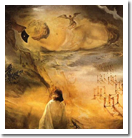About ID Arts
Our worldview impacts all areas of life including the arts. The arts also reflect philosophical and cultural trends in human societies. If philosophical and scientific concepts of intelligent design (ID) are valid, we believe they will both inspire, and be reflected in, our art, music, literature and film. Much of the focus of the ID movement to date has been on left-brain activities (logical, sequential, rational, analytical, objective, focused on parts). We believe there is also a right-brain approach to the issues (more intuitive, focused on the creative process, standing back looking at the whole and not just the parts) that may speak to an even wider audience through the arts. Some people, who might never crack a science book, will grasp ID concepts through image, lyric, or prose.
Francis Schaeffer summarizes the connection between our thought life and creativity as follows:
“There is a flow to history and culture. This flow is rooted and has its wellspring in the thoughts of people. People are unique in the inner life of the mind—what they are in their thought world determines how they act. This is true of their value systems and it is true of their creativity ….The results of their thought world flow through their fingers or from their tongues into the external world. This is true of Michelangelo’s chisel, and it is true of a dictator’s sword.”
— How Should We Then Live? Francis Schaeffer
We’ve been talking with artists, musicians, authors, poets, and filmmakers about these ideas and we’ve discovered several who are already producing creative works that fit into the ID Arts category. This website features the work of some of these artists and we hope will inspire others. Our desire is that the ID Arts initiative will open up a whole new dialogue in our culture about whether we live in a world of chance or a world of design.
About the Image
The discovery of the helix-shaped DNA by Crick and Watson was viewed by artist Salvador Dali as evidence of the intelligent design of life and one of the inspirations for his 1963 painting Galacidalacidesoxyribonucleicacid shown here. For more background and interpretation on this complex work see the commentary by Jonathan Ashar.
